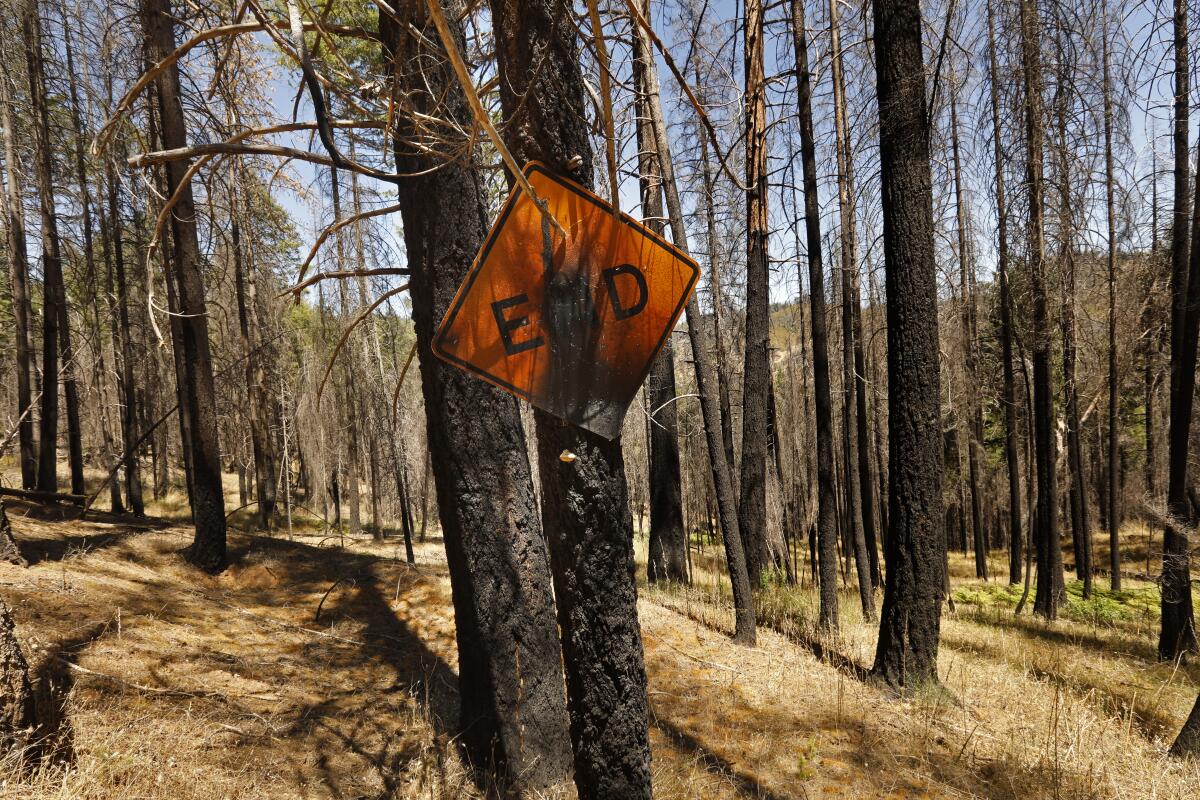California’s carbon-offset forests aren’t trapping much carbon. Here’s how to do better

- Share via
Many companies promising “net-zero” emissions to protect the climate are backing that claim by investing in vast swaths of forests to recapture carbon. It turns out this strategy isn’t working very well.
On paper, carbon offsets appear to balance out a company’s carbon emissions: The company pays to protect trees, which absorb carbon dioxide from the air, reducing the company’s net impact on the climate.
However, our new satellite analysis reveals what researchers have suspected for years: Forest offsets might not be doing much for the climate.
When we looked at satellite tracking of tree stocks and logging activity in California, we found that forest biomass isn’t increasing in the state’s 37 offset project sites any more than in other areas, and timber companies aren’t logging less than they did before companies invested in protecting that land.
The findings send a pretty grim message about efforts to control climate change, and they add to a growing list of concerns about forest offsets. Studies have already shown that projects are often overcredited at the beginning and might not last as long as expected. In this case we’re finding a bigger issue: a lack of real climate benefit over the 10 years of the program so far.
But we also see ways to fix the problem.
In California, landowners can receive carbon credits for keeping the stock of trees on their property above a minimum required “baseline” level.
Forest owners can then sell the carbon credits to companies, with the idea that the investment has protected trees that would otherwise be cut down. Large oil and gas companies use offsets to meet up to 8% of their state-mandated reductions in emissions.
California has one of the world’s largest carbon offset programs, with tens of millions of dollars flowing through offset projects, and is often a model for other countries that are planning new offset programs. Forest offsets and other “natural climate solutions” have received a great deal of attention from companies, governments and nonprofits, including during the U.N. climate conference this month in Egypt.
Offsets are playing a large and growing role in climate policy, and they need to be backed by the best available science.
Our study used satellite data to track forest biomass, tree harvesting rates and tree species in offset projects compared with other similar forests in California.
Satellites offer a more complete record than on-the-ground reports collected at offset projects. That allowed us to assess all of California since 1986, both before and after the offset program began in 2012.
We found that carbon isn’t being added to biomass on these lands faster than before the projects began or faster than in areas that are not used as offsets. Also, although tree biomass may be kept above the baseline as required, timber from these lands has been heavily harvested and continues to be harvested. Many offset sites are owned and operated by large timber companies.
In some regions, projects are being put on lands with lower-value tree species that aren’t at risk from logging. For example, at one large timber company in the redwood forests of northwestern California, the offset project is only 4% redwood, compared with 25% redwood on the rest of the company’s property. The offset project’s area is overgrown with tanoak, which is not marketable timber and doesn’t need to be protected from logging.
Our research points to a set of recommendations for California to improve its offsets protocols. This is particularly timely as the California Air Resources Board will hold a public workshop Wednesday to discuss science, data and tools toward future amendments to the offsets protocol.
One is to begin using satellite data to monitor forests and confirm that they are indeed being managed to protect or store more carbon. Publicly available satellite data are improving and can help make carbon offsetting more transparent and reliable.
California can also avoid putting offset projects on lands that are already being conserved. We found several projects owned by conservation groups on land that already had low harvest rates.
The state could improve its offset contract protocols to make sure landowners can’t withdraw from an offset program in the future and cut down those trees. Currently there is a penalty for doing so, but it might not be high enough. Landowners may be able to begin a project, receive a huge profit from the initial credits and cut down the trees in 20 to 30 years — paying the penalty at that time in dollars that are likely to be worth less because of inflation.
Finally, California should require offset projects to build in more of a buffer to account for the warming climate. The state requires only 2% or 4% of carbon credits be set aside in an insurance pool against wildfires, even though multiple projects have been damaged by recent fires. The pool may soon be depleted as yearly burned area increases in a warming climate. The insurance pool must be large enough to cover the worsening droughts, wildfires and disease and beetle infestations.
Once they have a clear-eyed view of how forest offsets work — or don’t — policy makers should consider investing in other climate-mitigation measures, like solar and electrification projects in low-income urban areas. Such investments may provide more cost-effective, reliable and just outcomes.
Without improvements to the current system, we may be underestimating our net emissions, contributing to the profits of large emitters and landowners, and distracting from the real solutions of transitioning to a clean-energy economy.
Shane Coffield is a postdoctoral scientist in biospheric sciences at the NASA Goddard Space Flight Center in Greenbelt, Md. James Randerson is a professor of Earth system science at UC Irvine. This article was produced in partnership with The Conversation.
More to Read
A cure for the common opinion
Get thought-provoking perspectives with our weekly newsletter.
You may occasionally receive promotional content from the Los Angeles Times.






